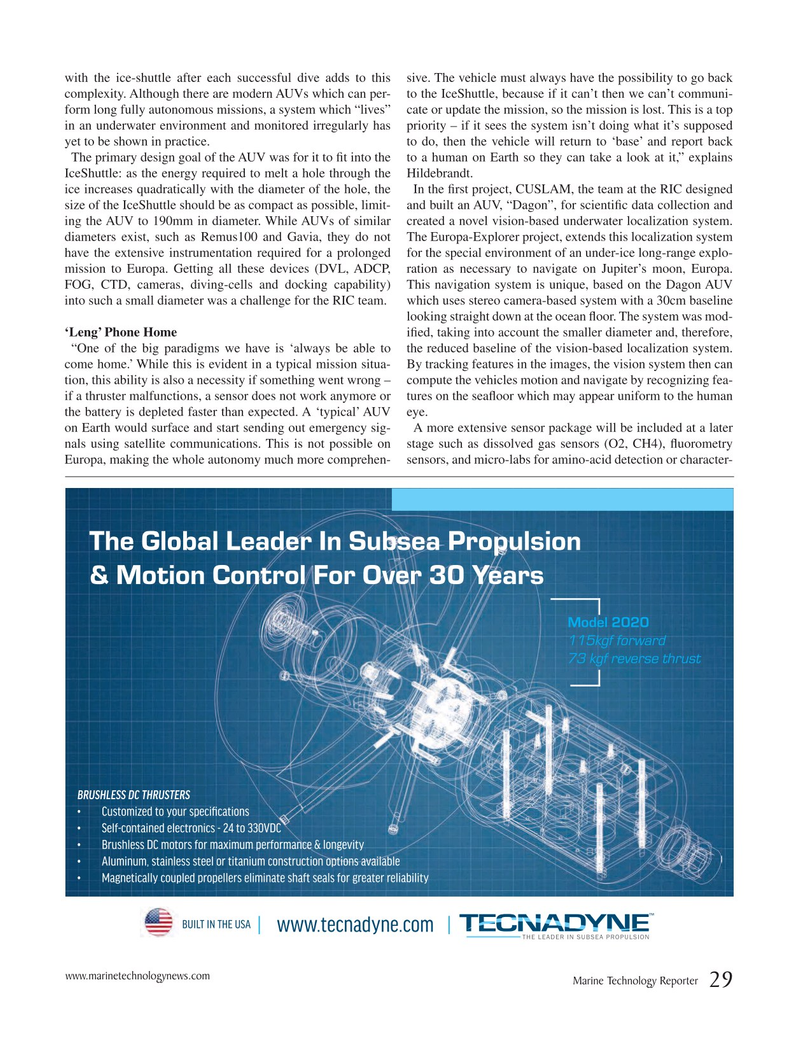
Page 29: of Marine Technology Magazine (October 2016)
AUV Operations
Read this page in Pdf, Flash or Html5 edition of October 2016 Marine Technology Magazine
with the ice-shuttle after each successful dive adds to this sive. The vehicle must always have the possibility to go back complexity. Although there are modern AUVs which can per- to the IceShuttle, because if it can’t then we can’t communi- form long fully autonomous missions, a system which “lives” cate or update the mission, so the mission is lost. This is a top in an underwater environment and monitored irregularly has priority – if it sees the system isn’t doing what it’s supposed yet to be shown in practice. to do, then the vehicle will return to ‘base’ and report back
The primary design goal of the AUV was for it to ? t into the to a human on Earth so they can take a look at it,” explains
IceShuttle: as the energy required to melt a hole through the Hildebrandt.
ice increases quadratically with the diameter of the hole, the In the ? rst project, CUSLAM, the team at the RIC designed size of the IceShuttle should be as compact as possible, limit- and built an AUV, “Dagon”, for scienti? c data collection and ing the AUV to 190mm in diameter. While AUVs of similar created a novel vision-based underwater localization system. diameters exist, such as Remus100 and Gavia, they do not The Europa-Explorer project, extends this localization system have the extensive instrumentation required for a prolonged for the special environment of an under-ice long-range explo- mission to Europa. Getting all these devices (DVL, ADCP, ration as necessary to navigate on Jupiter’s moon, Europa.
FOG, CTD, cameras, diving-cells and docking capability) This navigation system is unique, based on the Dagon AUV into such a small diameter was a challenge for the RIC team. which uses stereo camera-based system with a 30cm baseline looking straight down at the ocean ? oor. The system was mod- ‘Leng’ Phone Home i? ed, taking into account the smaller diameter and, therefore, “One of the big paradigms we have is ‘always be able to the reduced baseline of the vision-based localization system. come home.’ While this is evident in a typical mission situa- By tracking features in the images, the vision system then can tion, this ability is also a necessity if something went wrong – compute the vehicles motion and navigate by recognizing fea- if a thruster malfunctions, a sensor does not work anymore or tures on the sea? oor which may appear uniform to the human the battery is depleted faster than expected. A ‘typical’ AUV eye.
on Earth would surface and start sending out emergency sig- A more extensive sensor package will be included at a later nals using satellite communications. This is not possible on stage such as dissolved gas sensors (O2, CH4), ? uorometry
Europa, making the whole autonomy much more comprehen- sensors, and micro-labs for amino-acid detection or character-
The Global Leader In Subsea Propulsion & Motion Control For Over 30 Years
Model 2020 115kgf forward 73 kgf reverse thrust
BRUSHLESS DC THRUSTERS • Customized to your specifcations • Self-contained electronics - 24 to 330VDC • Brushless DC motors for maximum performance & longevity • Aluminum, stainless steel or titanium construction options available • Magnetically coupled propellers eliminate shaft seals for greater reliability ™
BUILT IN THE USA www.tecnadyne.com
THE LEADER IN SUBSEA PROPULSION www.marinetechnologynews.com
Marine Technology Reporter 29
MTR #8 (18-33).indd 29 9/27/2016 1:55:03 PM

 28
28

 30
30
